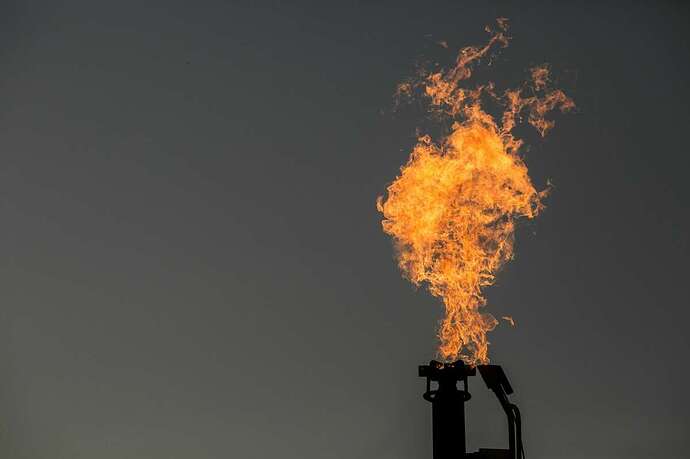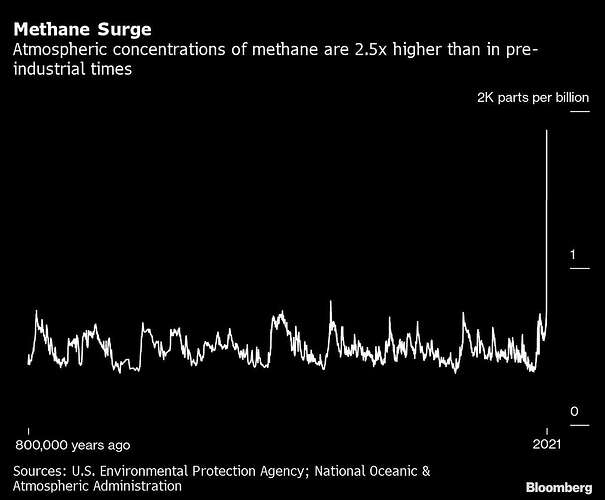(Bloomberg) – Exxon Mobil Corp. failed to initially report a release of the super-potent greenhouse gas methane in the Permian Basin that occurred in early February, violating state rules.
The incident at the company’s facility in New Mexico was reported after it reviewed a third-party satellite image. Exxon is the biggest US operator to publicly acknowledge a misstep in reporting its emissions since high-resolution satellite imagery of methane concentrations has become more widely available in the last few months. It also comes at a delicate moment after Exxon disclosed last week that the Justice Department may seek a fine for a well blowout in Ohio that caused an enormous methane leak in 2018.
The White House has already been pursuing new policies to empower private citizens to police oil wells and pipelines for leaks. It’s part of a stepped-up agenda to curb emissions of methane, the primary component of natural gas that has more than 80 times the warming power of carbon dioxide during its first 20 years in the atmosphere. Methane is responsible for approximately 30% of the Earth’s warming since the Industrial Revolution, and halting releases could do more to slow climate change than almost any other single measure.
Exxon discovered and fixed the leak on Feb. 5, and blamed its failure to initially notify regulators on human error, saying someone forgot to file a form. “We filed a notification with the state regulator, however our filing was unfortunately submitted after the required reporting time,” the company said in a statement. Exxon this week amended the filing, revising up the amount to 529,000 cubic feet from 448,000 cubic feet. Operators in New Mexico with releases caused by an emergency or malfunction that exceed 500,000 cubic feet must notify regulators verbally or through an email within 24 hours and must file a more detailed description of the event within 15 days. Releases less than 500,000 cubic feet need only submit notification within 15 days.
On Feb. 24, Bloomberg Green shared with Exxon satellite images made on Feb. 5 near the company’s Big Eddy Unit 156 in New Mexico. The images, taken from NASA’s EMIT imaging spectrometer on the International Space Station, appear to show a cloud of methane over the facility. Exxon notified state regulators of a release from the facility about five hours after Bloomberg emailed the company.
“The way the rules are set up in places like New Mexico it’s left up to companies to self measure and self report,’’ said Andrew Logan, a senior director at Ceres, a not-for-profit coalition of investors and companies advocating sustainability. “There’s a strong case that third party monitoring has a strong role to play, especially as satellite data has improved visibility into what’s happening in the oil field.’’
New Mexico’s Energy, Minerals and Natural Resources Department’s Oil Conservation Division (OCD) told Bloomberg Green it’s investigating the Feb. 5 plume and other methane clouds detected by NASA and other entities to evaluate operator compliance. Officials with OCD also conducted a physical inspection of the site.
Exxon is the third US operator this year to report a release of gas to state regulators after Bloomberg shared with the companies satellite images that appeared to show releases near their facilities. The Texas-based company, which reported a record $59 billion profit for 2022 earlier this year, said it’s working to improve its advanced monitoring and mitigation system that it says will help it achieve a goal of net zero emissions in the Permian Basin by 2030.
Exxon’s 2018 well blowout in Ohio was tracked by a team of scientists using satellites. The researchers estimated the blowout spewed more methane over a 20-day period than the entire oil and gas industry of Norway releases in a year, based on the country’s reported emissions. Exxon’s XTO unit gave warning of a potential fine from the DOJ in a regulatory filing, saying that it “strongly disagrees” with the department’s initial position and that it’s assessing the “factual basis of the allegation and any associated penalties.”
The Feb. 5 release in New Mexico, which was caused by a fitting that broke on a high-pressure gas line, was significantly smaller. The short term climate impact would be roughly equivalent to the annual emissions from about 170 US cars, according to calculations by Bloomberg.
Under the Biden Administration’s Super-Emitter Response Program, proposed by the Environmental Protection Agency, individuals who have agency-approved expertise and equipment would be authorized to monitor oil industry operations for emissions of the potent greenhouse gas and notify companies of any high-volume leaks. Operators would have five days to analyze any credible third-party methane reports and 10 days to fix most leaks.
Earlier this year, New Mexico said it opened an investigation after a high-resolution satellite appeared to show a cloud of methane near an APA Corp. oil and gas facility. Separately, Texas regulators said in February they are probing why pipeline operator Targa Resources Corp. failed to report an unexpected release of tons of natural gas within 24 hours, as required by state regulations. In both instances the operators filed emissions reports after being contacted by Bloomberg with the satellite images.
–With assistance from Kevin Crowley and Jennifer A Dlouhy.

